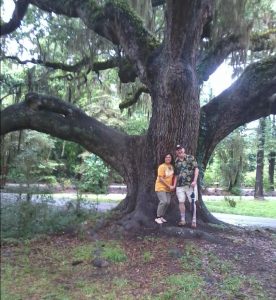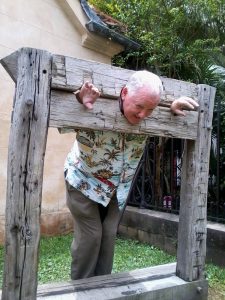
Linda, my friend, cringed as I showed her a photo from my vacation. I was perplexed by her reaction to a picture of a majestic 300 year old tree at the Magnolia Plantation in Charleston, South Carolina.
She gently enlightened me that the massive tree trunk anchored to the ruddy earth bears silent witness to the limp, bruised bodies that once dangled on its gnarled branches as a warning to others of the consequence of disobedience. Its appearance and longevity, though impressive, is a testament to many years of bondage in suffering and cruelty.
Slavery was the fate of captured enemies; or the method to pay off debt by the indentured. Slaves were used in Europe for the development of rugged land into cities and the accumulation of wealth.
The practice of slavery was transplanted to America by early colonizers using free labor to build economies and expand settlements. It became critical in labor intensive Southern colonies to force enslaved people to manage large homes, livestock and agricultural plantations.

Slavery was legal in the 13 colonies when independence from England was declared in 1776 to form the United States of America . However, since 1688, there already existed an abolitionist movement recognizing the universal rights of all people. As the country grew, accepting new states into the Union; many states abolished slavery, while an equal number continued the practice.
Slavery was a divisive issue. Free states and slave states jockeyed to maintain balance of power in Congress and control of the federal government. Inflamed by the 1860 election of Abraham Lincoln who campaigned on an anti-slavery expansion platform, the sovereign right of States to preserve slavery was the primary topic of disagreement. Of the thirty-four states that were part of the Union before the American Civil War of 1861, eleven slave states seceded to form the Confederate States of America.
South Carolina was the first state to secede from the Union, seizing federal properties within its borders. On April 12, 1861, South Carolina militia forces fired shots against Union troops occupying Fort Sumter, located at the mouth of Charleston Harbor. It ignited the Civil War; the deadliest war in American history. Fort Sumter was surrendered to the Confederates prompting President Lincoln to station hundreds of war ships to form a blockade and prevent the flow of commerce and the movement of weapons out of all Southern ports including Charleston.

It is in this climate of chaos that Robert Smalls, an illiterate negro slave, achieved his heroic feat. Born into slavery, Smalls worked in Charleston to earn money for his owner. He was hired to work on the CSS Planter, an armed transport and dispatch steamboat which carried guns and ammunition for the Confederate army. Smalls learned to pilot the vessel, memorizing the protocol for blowing whistles at appropriate check points to ensure safe passage.
On May 13, 1862, when the white officers of the Planter left ashore for the night, Smalls and the remaining black crew members hijacked the boat, picking up family and friends on the way, then sailing with its 16 passengers of black men, women and children towards the Union blockade and freedom.
Smalls was hailed for his daring escape. He was appointed as the first African American captain of a vessel in U.S. service and became a naval hero fighting for the Union. He continued to push for equal rights using politics as a tool for change; serving as a South Carolina state representative and senator before serving as congressman in the U.S. House of Representatives.
Slavery is a wound that does not heal, a pain that does not pause; yet Smalls was magnanimous in life as in death. After the war, he purchased the home where he was born and allowed the now penniless widow of his former slave owner to live the rest of her life as a member of his own family. Smalls died as the master and owner of the same house where he once was born a slave.
Click here for more American stories.